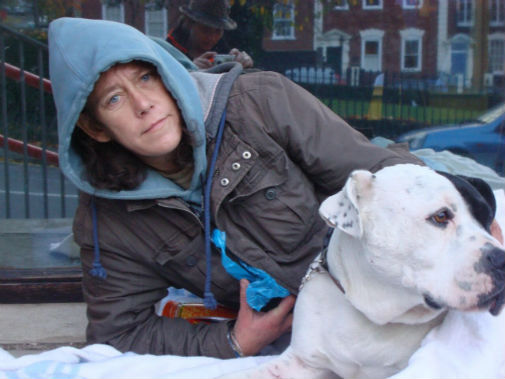Homeless heritage – how archaeology can give those sleeping rough a voice
Posted on 8 November 2017

Several homeless people who took part in the project said it gave them confidence. Pic Credit: Dr Rachael Kiddey
Dr Rachael Kiddey worked with around 40 homeless people on the Homeless Heritage project, believed to be the first of its kind in the UK. She has now written a book detailing the project and her experiences.
The homeless volunteers were able to provide a detailed ‘homeless map’ – often places that are overlooked, such as disused buildings, abandoned industrial parts of town, under bridges, in bin stores and neglected ruins in parks.
Bristol and York
The volunteers then worked alongside students to excavate two sites in Bristol and York and record what they found.
Dr Kiddey, who led the project as part of her PhD at York, said the book complements a growing body of literature that blends academic research findings with personal narrative.
She said: “The initial aim of the Homeless Heritage project was to see whether approaching a contemporary culture using archaeological methods could tell us anything new.
“A second question was, would homeless people be at all interested in heritage? The answer to both of these questions is yes.”
The two digs uncovered ceramic, glass, building materials but the team also found material related specifically to homelessness such as phone cards, portable food packaging and material related to drug use.
“As archaeologists we tend to dig up sites of massacres or battlefields, really dark, inhumane material. Homeless people come up with great ideas and notice things we wouldn’t normally notice, Dr Kiddey added.
“Working with homeless people as colleagues, we were able to interpret what the materials we found were, what they meant, how they were used. This showed us some new insights into homelessness.”
Confidence
Several homeless people who took part in the project said it gave them the confidence they needed to voluntarily engage with existing addiction services and get back on their feet.
Dr Kiddey said there was scope for the project to be copied by homeless outreach services.
She added: “The key is to develop a team dynamic and also offer a sense that people are capable of being useful members of society, that they are missed if they don’t turn up to work.
“This element was essential to the success of our project - people cared about the work we did and also grew to care about one another and themselves. This was the truly therapeutic aspect.”
The book, Homeless Heritage: Collaborative Social Archaeology as Therapeutic Practice, is published by Oxford University Press.
Further information:
A book launch is taking place in Oxford on 10th November. Tickets are free but registration is essential. More details can be found here: https://www.eventbrite.co.uk/e/homeless-heritage-book-launch-tickets-38831742788
Explore more news

New butterfly species created 200,000 years ago by two species interbreeding
Thursday 18 April 2024

Children in the North at greater risk of entering care
Wednesday 17 April 2024

Boreal forest and tundra regions worst hit over next 500 years of climate change, study shows
Monday 8 April 2024

Researchers developing ultra-sensitive blood test with potential to revolutionise diagnosis of Alzheimer’s
Thursday 4 April 2024

Attitudes to being an adult are shifting as traditional milestones become out of reach, new study finds
Wednesday 27 March 2024
Media enquiries
About this research
Dr Rachael Kiddey led a project working with homeless people on two archaeological digs. It formed part of her PhD at York and resulted in the book, Homeless Heritage: Collaborative Social Archaeology as Therapeutic Practice, published by Oxford University Press. The study was self-funded. Dr Kiddey is now a Postdoctoral Researcher at the Pitt Rivers Museum, University of Oxford.
